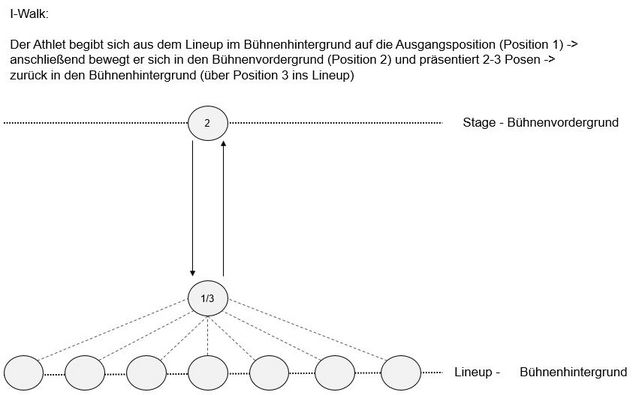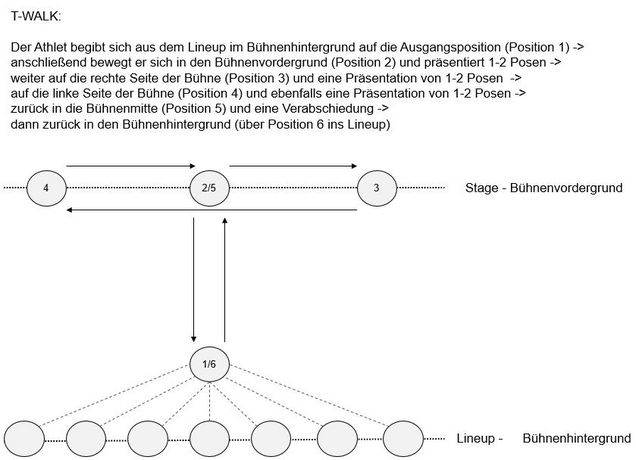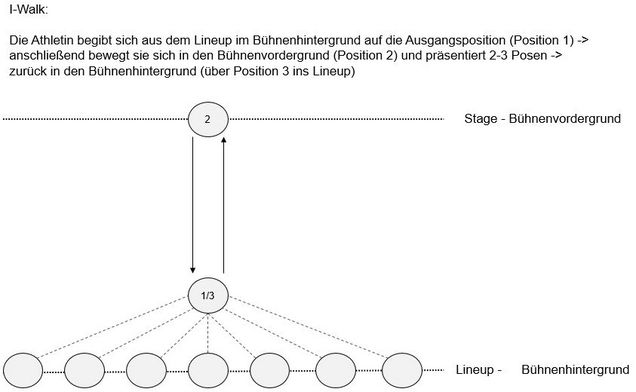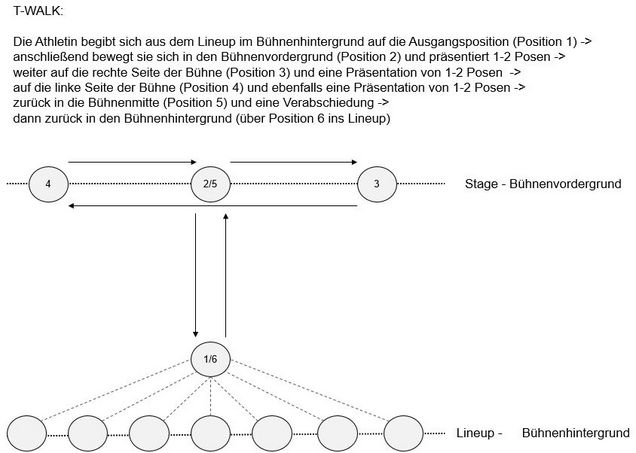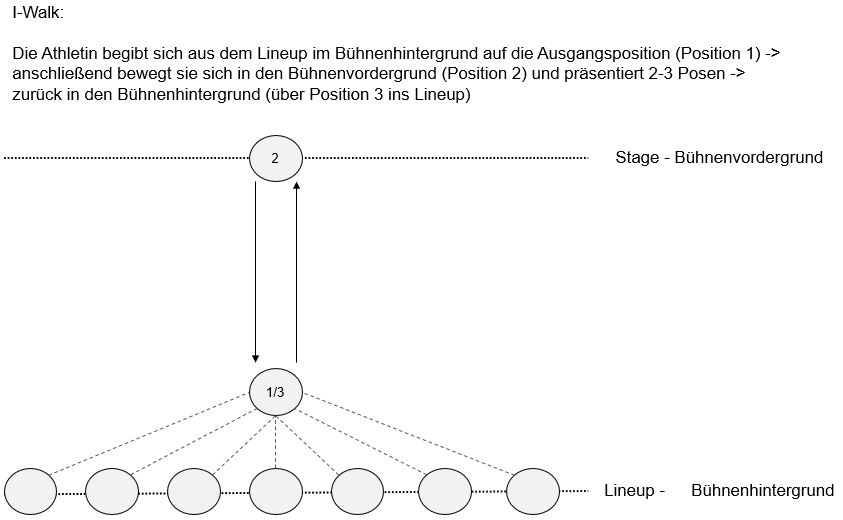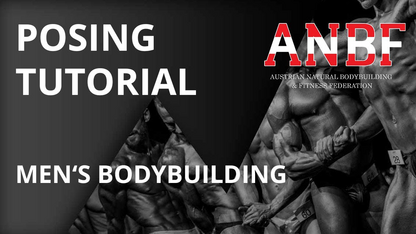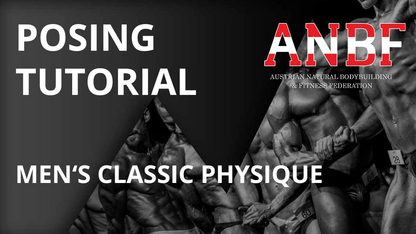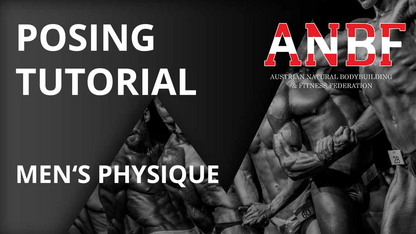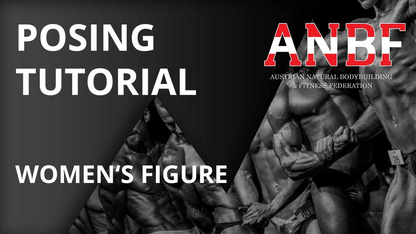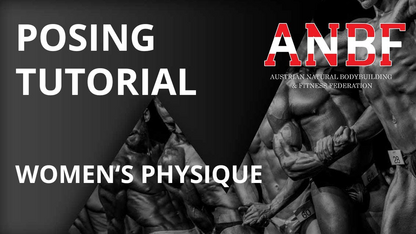If you split the body down the middle from top to bottom, we have the right side and the left side. Both sides look the same at first glance. So symmetry means how exactly equal is the left side to the right. If you mirrored a page we would have 100% equality. Detailed means that e.g. the right leg is the same thickness as the left leg, the right breast is the same height as the left breast, etc.
Think of the "hourglass" as meaning the proportion of body/muscle parts to each other. The upper body and lower body should be developed at the same time. Detailed means, for example, that the calf muscles should not be larger than the thighs, or the biceps should be oversized, while the back muscles are hardly developed. The body should be muscular and balanced. The overall picture could also be disturbed by oversized breasts, for example.
It describes the low body fat percentage. As a result, the musculature comes into its own and appears "hard". This is also associated with vein marking and striated muscles.
Both the appearance and the overall impression remain decisive in all classes. This includes every criterion individually tailored to each body. This can also be how the athlete moves and presents. Naturalness and individuality describe each participant in their own way.
The athletes have a maximum age of 18 years (start up to and including the year in which you turn 18. If you are 18 and turn 19 in the same year, you can no longer start).
Judging criteria:
We are looking for an X-Fram, sweeping legs, a narrow part and a wide shoulder area. The whole thing is rounded off by a wide back section. The aim is to gain as much muscle mass as possible with a low body fat percentage.
The muscle mass and the definition, the so-called muscle hardness, are evaluated. This includes the symmetry and balance of muscle groups, upper body to lower body and front to back view. The final deciding factor is the presentation. These components then result in an overall impression that results in a rating.
Symmetry (quarter turns):
- Characteristics of the musculature upper to lower body
- Characteristics of the musculature front to rear view
Muscular characteristics (comparison poses):
- muscle mass
- muscle definition
Posing and stage presence are included in the overall rating.
Freestyle:
- 60s individual posing with music
- Music must be uploaded to the membership site
- The top 5 may present the freestyle, this is not included in the overall ranking.
Competition clothing:
Posing briefs are worn. The buttocks must be covered in a V-shape. Advertisements and imprints are not allowed.
Classes:
- Teenagers (up to 18 years)
- Juniors (up to 21 years)
- men masters
- men body building
Mandatory poses:
- Front double biceps
- Lat front
- Side chest pose
- Side tricep pose
- Double biceps from behind
- Lat from behind
- abdomen and legs
- Most Muscular
Double starters:
Only possible within the men's bodybuilding classes listed here
Process:
All athletes enter the stage, with classes over 10 participants a so-called elimination round is carried out.
Elimination round:
- Lineup (quarter turns)
- Callouts (comparison poses)
- Top 10 Announced + Medal Award for Eliminated Athletes + Posedown
Main round (scoring round 1):
- Lineup (quarter turns)
- Callouts (comparison poses)
- Top 5 will be announced + medals awarded for 6-10
- All athletes leave the stage
Final (scoring round 2):
- Freestyle (voluntary, not included in the evaluation)
- comparisons
- pose down
- award ceremony
Overall Bodybuilding judging:
Upon completion of the bodybuilding classes, all class winners qualify for the overall judging.
Bans:
Oil-based paint such as Dream Tan ("gossip paint") is explicitly forbidden!
evaluation criteria:
The athlete may only reach a certain body weight. The maximum body weight is made up of height (cm) minus 98. If the athlete is 176 cm, the calculation (176 minus 98) results in a maximum body weight of 78 kg.
We are looking for an X-Fram, sweeping legs, a narrow part and a wide shoulder area. The whole thing is rounded off by a wide back section. The aim is to gain as much muscle mass as possible with a low body fat percentage.
The muscle mass and the definition, the so-called muscle hardness, are evaluated. This includes the symmetry and balance of muscle groups, upper body to lower body and front to back view. The final deciding factor is the presentation. These components then result in an overall impression that results in a rating.
Symmetry (quarter turns):
- Characteristics of the musculature upper to lower body
- Characteristics of the musculature front to rear view
Muscular characteristics (comparison poses):
- muscle mass
- muscle definition
Posing and stage presence are included in the overall rating.
Competition clothing:
No Posing Slips are worn as in the bodybuilding class. The Classic Physique Trunk must have a side width of min. 6 cm.
Athletes must wear a solid color, black, tight-fitting shorts without any advertising. The shorts must not be patterned or decorated.
freestyle:
- 60s individual posing with music
- Music must be uploaded to the membership site
- The top 5 may present the freestyle, this is not included in the overall ranking.
mandatory poses:
- Front double biceps
- Side chest pose
- Double biceps from behind
- abdomen and legs
- classic pose
Double starts:
No double start possible!
process:
All athletes enter the stage, with classes over 10 participants a so-called elimination round is carried out.
elimination round:
- Lineup (quarter turns)
- Callouts (comparison poses)
- Top 10 Announced + Medal Award for Eliminated Athletes + Posedown
Main round (scoring round 1):
- Lineup (quarter turns)
- Callouts (comparison poses)
- Top 5 will be announced + medals awarded for 6-10
- All athletes leave the stage
Final (scoring round 2):
- Freestyle (voluntary, not included in the evaluation)
- comparisons
- pose down
- award ceremony
Classic Physique overall judging:
The class winners of the Classic Physique compete for the overall victory of the Classic Physique.
ban:
Oil-based paint such as Dream Tan ("gossip paint") is explicitly forbidden!
Judging criteria:
The athlete may only reach a certain body weight. The maximum body weight is made up of height (cm) minus 98. If the athlete is 176cm, the calculation (176 minus 98) results in a maximum body weight of 78 kg.
You are looking for a V-frame, a narrow waist, pronounced abdominal muscles and broad shoulders. This is completed by a well-trained back or Latinism, which results in the V-shape.
The muscle mass and definition of the muscles are evaluated. The muscle mass should also match the V-structure. Symmetry of the halves of the body and balance of the front and back of the body are included in the evaluation. There is another decisive factor, the presentation and the charisma on stage. This results in an overall impression, which is reflected in the rating.
Symmetry (quarter turns):
- V-frame - narrow waist, broad shoulders
- Pronounced latissimus
Muscular characteristics (comparison poses):
- muscle mass
- covered by weight limit, an aesthetic V-taper look is sought
- muscle definition
Physical Appearance:
- The overall appearance of the athlete, stage presentation, swimming trunks, tanning, hair, etc. is included in the overall evaluation.
Competition clothing:
Participants in the Mr. Physique class will wear boardshorts with a length that ends just above the knees and a height that starts below the belly button. Boardshorts may be solid or multi-colored. Tight fitting spandex shorts (bike shorts) are not allowed.
Classes:
- Juniors Men`s Physique (up to 23 years)
- Men's Physique (up to 180cm)
- Men's Physique (over 180cm)
- Masters Men's Physique
mandatory poses:
- Double biceps from the front
- Side chest pose (side of choice)
- Side Tricep Pose (side of choice)
- Double biceps from behind
- abs
Hands may be clenched into fists.
Double starters:
Only possible within the Men's Physique classes listed here
process:
All athletes enter the stage, with classes over 10 participants a so-called elimination round is carried out.
elimination round:
- Lineup (quarter turns) + comparison poses
- Top 10 will be announced + award of medals for eliminated athletes
Main round (scoring round 1):
- Lineup (quarter turns)
- Callouts (comparison poses)
- Top 5 will be announced + medals awarded for 6-10
- All athletes leave the stage
Final (scoring round 2):
- I walk
- comparisons
- pose down
- award ceremony
Mens Physique overall judging:
The class winners of the Mens Physique compete for the overall victory of the Men's Physique.
Evaluation criteria:
What is wanted is the classic hourglass shape – a narrow waist between a pronounced shoulder and hip area. A trained back completes the picture. No abdominal muscles need to be visible on the flat middle section. The aim is to present an athletic and feminine appearance without great muscle volume and muscle hardness.
Symmetrically developed halves of the body and harmonious proportions are judged. Not only is there a balance between the individual muscle groups, the upper body and lower body are also developed evenly. Another important factor is the harmony and presentation on stage. The overall impression also includes clothing, make-up, jewellery, hairstyle and charisma. In addition to doing quarter turns, bikini athletes perform a t-walk where they present their form from all four sides.
High heels up to a maximum of 15 cm (incl. platform) are worn in this class. A two-piece bikini must be worn. The bikini class is divided into "Bikini I" and "Bikini II" from a height of 165 cm.
Fitness & Balance:
Muscular characteristics:
- Looking for:
- Round shoulders
- Approaches of divisions of the leg muscles
- attachments of abdominal muscles
- tight glutes
- In general, a sporty, rather delicate look is sought.
- An overly defined and vascular musculature or too much musculature (figure) has a negative effect on the ranking
Physical Appearance:
- The overall appearance of the athlete, stage presentation, bikini, tanning, hair, make-up etc. is included in the overall rating.
Double starters:
Only possible within bikini classes.
process:
All athletes enter the stage, in classes with more than 10 participants a so-called elimination round is carried out.
elimination round:
- Lineup (quarter turns)
- Top 10 will be announced + awarding of medals for eliminated athletes
Main round (scoring round 1):
- Lineup (quarter turns)
- Callouts (comparison poses)
- Top 5 will be announced + medals awarded for 6-10
Final (scoring round 2):
- I walk
- comparisons
- award ceremony
Bikini overall judging:
The class winners of the Bikini class compete for the overall victory of the bikini class.
evaluation criteria:
An X-frame is wanted - sweeping legs, a narrow waist and broad shoulders. A wide back part completes the picture. The aim is to show muscle attachments on the chest, abdomen, legs and bottom. A division or striation of the large muscle groups is not desirable.
The figure class is an upgrade of the bikini class. Muscle volume is also assessed. The athlete presents symmetrically developed halves of the body and harmonious proportions. Not only is there a balance between the individual muscle groups, the upper body and lower body are also developed evenly. Another important factor is the harmony and presentation on stage. The overall impression also includes clothing, make-up, jewellery, hairstyle and charisma. Figure athletes assume four different basic poses (quarter twists) in which they present their form from all four sides.
High heels up to a maximum of 15 cm (incl. platform) are worn in this class.
Symmetry (quarter turns):
- Balanced musculature upper to lower body
- Balanced musculature front to back view
Muscular characteristics (comparison poses):
- Good muscle tone
- some muscle definition and muscle mass is expected
- good definition of muscle divisions and full muscle bellies
- Muscles that are too defined and vascular have a negative effect on the ranking
- Muscle mass and definition should fit into the class, so it will be rated accordingly
Physical Appearance:
The overall appearance of the athlete, stage presentation, bikini, tanning, hair, make-up etc. is included in the overall rating.
Process:
All athletes enter the stage, in classes with more than 10 participants a so-called elimination round is carried out.
elimination round:
- Lineup (quarter turns)
- Top 10 will be announced + awarding of medals for eliminated athletes
Main round (scoring round 1):
- Lineup (quarter turns)
- Callouts (quarter turns)
- Top 5 will be announced + medals awarded for 6-10
Final (scoring round 2):
- I walk
- comparisons
- award ceremony
Overall Figure:
The Figure class winners compete for the overall Figure class win.
evaluation criteria:
An X-frame is wanted - sweeping legs, a narrow waist and broad shoulders. A wide back part completes the picture. The aim is to show pronounced muscle parts on the chest, back, abdomen, legs and buttocks. A division of the large muscle groups is desired. The small muscle groups should be visible.
The Physique class is an increase in the figure class. Both muscle volume and muscle hardness are evaluated. The athlete presents symmetrically developed halves of the body and harmonious proportions. Not only is there a balance between the individual muscle groups, the upper body and lower body are also developed evenly. Another important factor is the harmony and presentation on stage. The overall impression also includes clothing, make-up, jewellery, hairstyle and charisma. Physique class athletes perform five other basic poses (front biceps, side chest, back biceps, side triceps, abs and legs) in addition to quarter twists.
A freestyle posing is possible. Shoes are not allowed, there is no weight limit in this class.
Symmetry (quarter turns):
- Characteristics of the musculature upper to lower body
- Characteristics of the musculature front to rear view
Muscular characteristics (comparison poses):
- muscle mass
- muscle definition
- A very well developed musculature is sought, divisions should be clearly recognizable and vascular musculature and good muscle definition are desired.
Posing and stage presence are included in the overall rating.
freestyle:
- 60s individual posing with music
- Music must be uploaded to the membership site
- The top 5 may present the freestyle, this is not included in the overall ranking.
Compulsory poses:
- Double biceps from the front (one leg spread to the side, hand position open).
- Side chest pose.
- Double biceps from behind (one leg spread to the side, hand position open).
- Side Triceps Pose.
- abdominal and legs (hands behind head, one leg put forward).
process:
All athletes enter the stage, in classes with more than 10 participants a so-called elimination round is carried out.
elimination round:
- Lineup (quarter turns)
- Callouts (comparison poses)
- Top 10 Announced + Medal Award for Eliminated Athletes + Posedown
Main round (scoring round 1):
- Lineup (quarter turns)
- Callouts (comparison poses)
- Top 5 will be announced + medals awarded for 6-10
- All athletes leave the stage
Final (scoring round 2):
- Freestyle (voluntary, not included in the evaluation)
- comparisons
- pose down
- award ceremony
Overall Physique:
The class winners of Physique will compete for the overall victory of the Physique class.
Two athletes constitute a unit and are scored equally.
The two participants should appear harmoniously in their performance (compulsory freestyle) as well as in their basic poses. The main criterion here is the overall appearance. The pair must match each other as much as possible. Proportion and symmetry (weaknesses and strengths) are decisive here. Muscle development should start at the same level for both athletes in relation to their gender.
Couples can, but do not have to, be mixed. The pair posing is the only class in which the compulsory posing routine is evaluated.
Symmetry (quarter turns):
- Characteristics of the musculature of the couple
- Balance of the two participants
Freestyle is included in the rating:
- Stage presence, acrobatics and sense of rhythm are evaluated here.
Process:
- Round of symmetry - quarter turns
-
mandatory posing routine – will be evaluated!
- award ceremony
